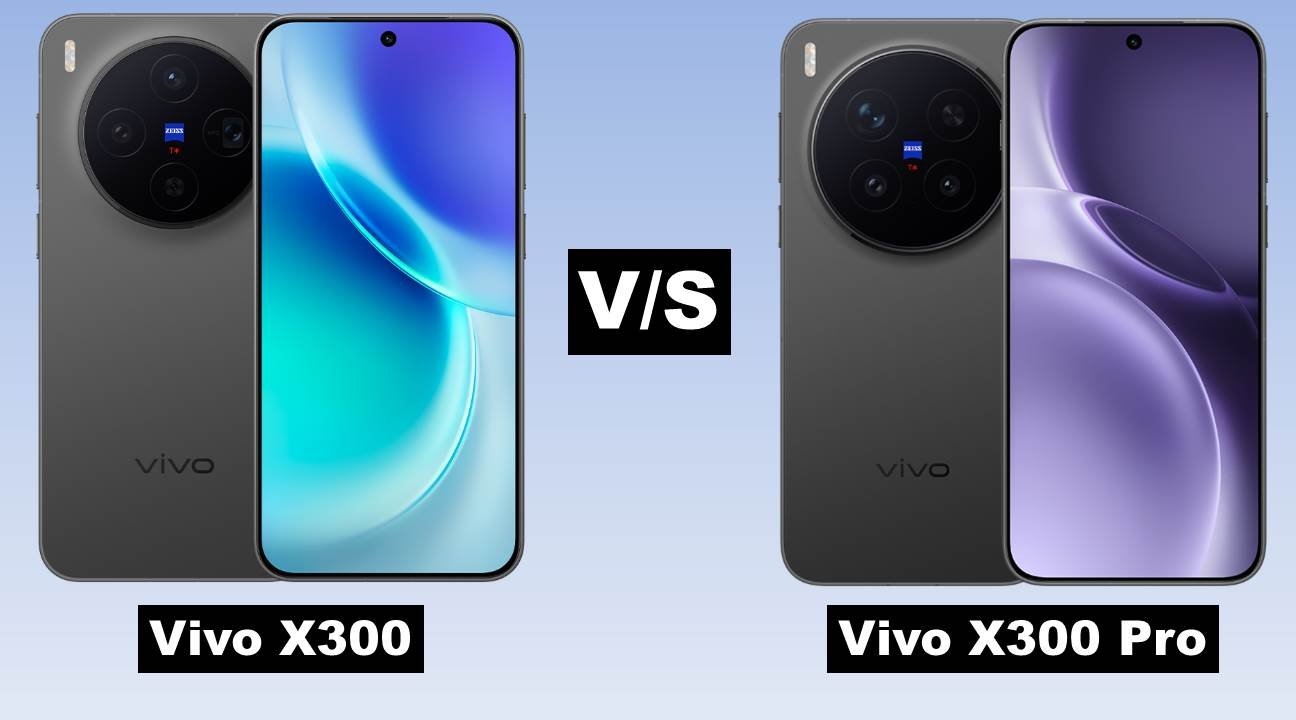
The Vivo X300 series has officially made its debut, introducing two impressive smartphones — the Vivo X300 and Vivo X300 Pro. Both models bring flagship-grade features, premium designs, and cutting-edge camera systems. However, there are several differences that set them apart, especially in display size, camera setup, and battery capacity. Let’s take a closer look at how the two devices compare.
Both the Vivo X300 and X300 Pro share a sleek, premium design with glass front and back and an aluminum alloy frame. They also carry an IP68/IP69 rating, offering dust and high-pressure water resistance.
The Vivo X300 is more compact and lightweight, measuring 150.6 x 71.9 x 8 mm and weighing 190 grams — ideal for users who prefer a manageable size. Meanwhile, the X300 Pro is larger and heavier at 161.2 x 75.5 x 8 mm and 226 grams, catering to those who like a bigger display and a more substantial feel in hand.
Verdict: X300 for compact design; X300 Pro for a premium large-screen experience.
Both phones use advanced LTPO AMOLED panels with 1B colors, 120Hz refresh rate, and HDR10+ support, ensuring excellent visuals. However, the Vivo X300 Pro gains the upper hand with Dolby Vision and a slightly larger 6.78-inch display compared to the 6.31-inch screen on the X300.
The Pro variant also has a higher resolution (1260 x 2800 pixels) and scratch/drop-resistant protection, while the standard model offers 1216 x 2640 pixels and unspecified protection.
Verdict: The X300 Pro wins with Dolby Vision and a larger, more immersive display.
Both models are powered by the MediaTek Dimensity 9500 (3 nm) chipset paired with the Arm G1-Ultra GPU, ensuring exceptional speed and efficiency. They run on Android 16 with Funtouch OS 16 (international) or OriginOS 6 (China) and promise up to four major Android upgrades.
In terms of performance, there’s no difference between the two — both are equally powerful and ideal for multitasking, gaming, and productivity.
Verdict: A tie in performance.
This is where the major distinction lies.
The Vivo X300 features a 200MP primary wide sensor, paired with a 50MP periscope telephoto lens and a 50MP ultrawide camera. This setup is optimized for clarity, detail, and color accuracy, with Zeiss optics and Zeiss T coating*.
On the other hand, the Vivo X300 Pro flips the setup — it has a 50MP main wide sensor with a larger 1/1.28-inch sensor, a 200MP periscope telephoto lens with 3.7x optical zoom, and a 50MP ultrawide sensor. It also supports 8K video recording, 10-bit Log, and Dolby Vision HDR, features missing on the standard model.
Verdict: X300 Pro offers superior camera versatility and video performance.
Both phones sport a 50MP front camera with autofocus and support for 4K video recording at 60fps. The selfie quality and dynamic range are expected to be nearly identical across both models.
Verdict: Equal selfie performance.
Both models deliver stereo speakers, Bluetooth 5.4, Wi-Fi 7, and USB Type-C 3.2 support. However, the Vivo X300 Pro includes 24-bit/192kHz Hi-Res audio and optional satellite connectivity, enhancing its multimedia and communication capabilities.
Verdict: X300 Pro takes the lead with Hi-Res audio and satellite support.
Battery life is another key differentiator. The Vivo X300 packs a 6040mAh battery with 90W wired and 40W wireless charging, plus reverse wired charging.
The Vivo X300 Pro comes with a larger 6510mAh battery, offering reverse wireless charging on top of the wired and wireless options.
Verdict: X300 Pro wins with a bigger battery and more versatile charging options.
Both phones will be released on October 17, 2025.
Verdict: X300 offers great value, but the Pro model justifies its higher price with added premium features.
The Vivo X300 is an excellent choice for users who want flagship performance, stunning design, and a powerful camera in a more compact and affordable package.
Meanwhile, the Vivo X300 Pro stands out as a true flagship beast — with Dolby Vision, 8K video recording, Hi-Res audio, satellite connectivity, and a larger battery — perfect for those who want the ultimate experience.
In short:
Comments